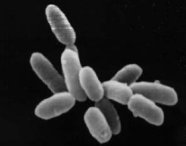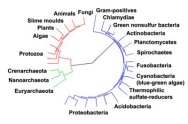 The
Archaea comprise a group of single-celled microorganisms that,
like bacteria, are prokaryotes that have no cell nucleus or
any other organelles within their cells. Consequently, they
were
once considered to be an unusual group of bacteria
and named archaebacteria.
However, it in now known that Archaeans have an independent evolutionary
history and have numerous differences in their biochemistry
compared to
other forms of life. The differences are so great that they are
now The
Archaea comprise a group of single-celled microorganisms that,
like bacteria, are prokaryotes that have no cell nucleus or
any other organelles within their cells. Consequently, they
were
once considered to be an unusual group of bacteria
and named archaebacteria.
However, it in now known that Archaeans have an independent evolutionary
history and have numerous differences in their biochemistry
compared to
other forms of life. The differences are so great that they are
now classified
as a distinctly separate domain in the three-domain system. Carl
Woese introduced the three main branches of evolutionary
descent as the Archaea, Eukaryota and Bacteria. Classifying
Archaea remains
difficult, since the vast majority of these organisms have never
been studied in the laboratory and have only been detected
by
analysis of their nucleic acids in environmental samples. classified
as a distinctly separate domain in the three-domain system. Carl
Woese introduced the three main branches of evolutionary
descent as the Archaea, Eukaryota and Bacteria. Classifying
Archaea remains
difficult, since the vast majority of these organisms have never
been studied in the laboratory and have only been detected
by
analysis of their nucleic acids in environmental samples.
 Archaeans
are an ancient form of life, possibly the most ancient.
Putative fossils of archaean cells in stromatolites
have been dated to almost 3.5 billion years ago, and the remains
of lipids that may be either archaean
or eukaryotic have been detected in shales dating from 2.7
billion
years ago. Since most prokaryotes do not have distinct morphologies,
the shapes of fossils cannot be used to identify them as Archaea.
Instead, chemical fossils, in the form of the unique lipids found
in archaeans are used, and such lipids have now been detected
in
rocks dating back to the Archaean. The oldest known traces
of these isoprene lipids have been found in Greenland, which
include
sediments formed 3.8 billion years old and are the oldest on
Earth; some scientists, however, dispute this claim. Archaeans
are an ancient form of life, possibly the most ancient.
Putative fossils of archaean cells in stromatolites
have been dated to almost 3.5 billion years ago, and the remains
of lipids that may be either archaean
or eukaryotic have been detected in shales dating from 2.7
billion
years ago. Since most prokaryotes do not have distinct morphologies,
the shapes of fossils cannot be used to identify them as Archaea.
Instead, chemical fossils, in the form of the unique lipids found
in archaeans are used, and such lipids have now been detected
in
rocks dating back to the Archaean. The oldest known traces
of these isoprene lipids have been found in Greenland, which
include
sediments formed 3.8 billion years old and are the oldest on
Earth; some scientists, however, dispute this claim.
The
Theory of Endosymbiosis proposes
that Eukaryotic life evolved from the Archaea. That is, the
theory
explains that organelles such as mitochondria and chloroplasts
in eukaryotic cells evolved from certain types of bacteria that
prokaryotic cells engulfed through endophagocytosis. These cells
and the bacteria trapped inside subsequently evolved a symbiotic
relationship. In this endosymbiotic relationship, the bacteria
lived within the other prokaryotic cells.
|



